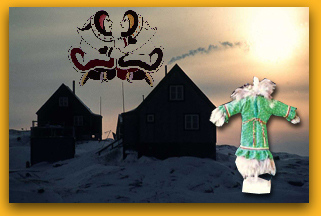
 |
 |
Inuit
Culture and |
|
Consequently, I believe that Peter's wife was continuously faced with many socio-economic and political problems, which included Anglican and Catholic religious beliefs, assimilation, segregation, division of labour, language barriers and the exposure to a nuclear household based on a heterosexual marriage. In addition to all this, I am sure she was experiencing considerable difficulty combining work and responsibilities on household chores and tried desperately imitating what her mother might have taught her. I can remember during my younger days, I learned to survive many obstacles which I confronted as an immigrant and worked the problem out as best as I could. There were times when my parents, sister and I would go without water for several days during the harsh winters because our pipes froze. My parents finally decided to boil the snow, similar to what Peter's wife may have done, to produce water for household purposes. I sincerely believe that Peter's wife was alienated by the white culture's family structure (nuclear family), which may have prevented her from socializing with her family and peers. The complications and effects would have been enormous at times; because she may have been torn between two worlds, each thinking their cause had valid points. This would have caused her to withdraw from society and prevented her from expressing her own identity as an individual. If I had been in her shoes, I would become deeply depressed and lonely, but on the other hand, if I had been exposed to two different environments, it may have taught me to visualize both sides of the coin and be able to teach my child the value of life as well as to what extent change was beneficial for the future of my people. A prophecy an Inuit woman may hold dear to her heart.
CONCLUSION When leaving a homeland (the Channel Islands) to come to a new land (New France), the future habitant (Peter) brings along personal, cultural and social values. When he disembarks in the community where he may choose to remain (St. Augustin), he meets individuals who come from that region (Innu). If a bachelor, he would probably marry a woman who was a native of that territory. Faced with the impossibility of creating relationships solely based on the ways of his own faith, region or place, Peter helped develop a new society. Because the country was so vast, the new settlers (Peter) may have lived in isolation for some time until they found their roots and began to grow with the arrival of new neighbours (Inuit and Innu) or of their own culture. At this point Peter could then establish with the new neighbours a community spirit and even a kindred relationship, building a support network: working at the seal fishery, hunting and trapping and the HBC. This ideology contributes tremendously to a permanent attachment to the land. The problem, though, is that Peter did not realize how much damage the Europeans caused towards the native lands and culture. Western society failed to recognize that much of the native culture revolved around their relationship to game mammals (fish, whale, caribou and so on), which had both realistic and spiritual aspects. Their interdependence with the animal world was, in fact, the focus of their religious and philosophical speculations. I think that the systems of life in Labrador/Quebec had already suggested the extent to which the western society came and sought, indirectly and directly, to effect change among the native people. For example, the Moravians and the Jesuits wanted the Inuit-Innu to assimilate and live in enclaves over which the missions could preside. Obviously, the Labrador/Quebec communities, like all other inhabited lands, have witnessed a great and complex flow of socio-economic and political orders (Garth Taylor, 1977). I believe Peter and others who traveled from afar have arrived, stopped, moved on, adjusted, changed and died away; societies have brought their specialized techniques and institutions from one part of the country to another, creating distinct cultures and molding distinctive types of personality, influencing their neighbours and becoming a vital part of their lives. Most of Peter's descendents remained in St. Augustin, Quebec as their permanent residence. The Innu once occupied these coasts of the St. Lawrence before they were pushed away by the French settlers on the east side of the St. Augustin River, presently called Pakua Shipi, an Innu reserve, while on the west side of the river, the French settlement is called St. Augustin, Quebec. In 1961, the Innu from St. Augustin and La Romain decided to establish their own community and in 1963 Pakua Shipi became their reserve. Their main languages are Innu, French and English. Similar to the Inuit, Western society fails to recognize that Innu land is also their history, their culture and their future. It is like a storehouse of wildlife that sustains them for generations and which they hope will continue to provide for them in the future. The arrival of Europeans disrupted Innu-Inuit history in many ways. The incorporation into the fur trade made them dependant on the HBC, the Moravians, missionaries and merchants. All of these groups tried to manipulate them to abandon their religion and tried to "civilize" them into the mainstream of industrial society by attacking them or by introducing them to trading posts. In other words, the natives were in trouble when the white trappers invaded the native trapping regions, contributing to the economic hardship of the natives and ultimately leading to reciprocal killing of Europeans. The worst impact of the European presence began in the 1600's, when the Innu and Inuit society contracted diseases like smallpox, measles, Spanish flu, tuberculosis, whooping cough and scarlet fever, just to name a few. These diseases took a horrible toll and reduced the Inuit and Innu population by as much as two-thirds by around 1920 (Bruce Cox, 1992). By the 1940-50's, tuberculosis was still a major problem, and starvation was a frequent threat. By then, the fur trade had collapsed and industrial society had expanded into the natives' harvesting areas. Iron ore mines in Shefferville, Labrador City and Wabush, a shipping boundary line at Sept-Isles and the military base at Goose Bay cut off enormous quantities of land without the natives' consent. According to Pakua Shipi, written by Denise Charron, the life of the Innu-Inuit in the government-built villages turned out to be devastating for them, because they were treated like children by missionaries and government bureaucrats, subject to humiliating racism by white society and punished by hunting regulations. These factors produced the predicaments of low self-esteem, family violence, alcohol abuse and other cultural collapse, such as the loss of spiritual beliefs. It was not until in the early 1960's and 1970's that the Innu began to turn things around, when their language and culture was introduced into the school curriculum to counter the previous negative messages about their heritage. They obtained programs to transport their people to the country so that they could regain their harvesting skills, the knowledge of their land and culture, and oral traditions that could be passed on to the younger generations. I think today Peter's wife would be proud of her culture, because they have never forgotten the link between the spirit world and the human world. They have succeeded in adapting and making a place for themselves in one of the harshest regions in the world. Also, the creative art of making deer hide clothing has paid off, because presently Inuit women can be considered as some of humanity's best clothes designers - both lovely and practical (Michael Noel, 1997).
|
|